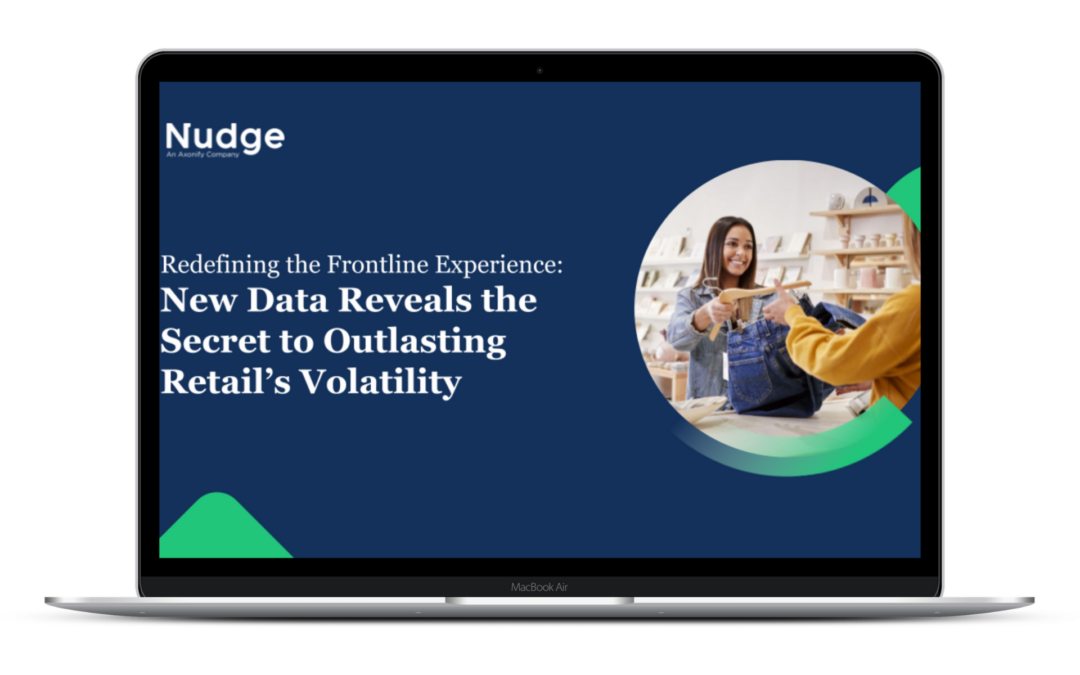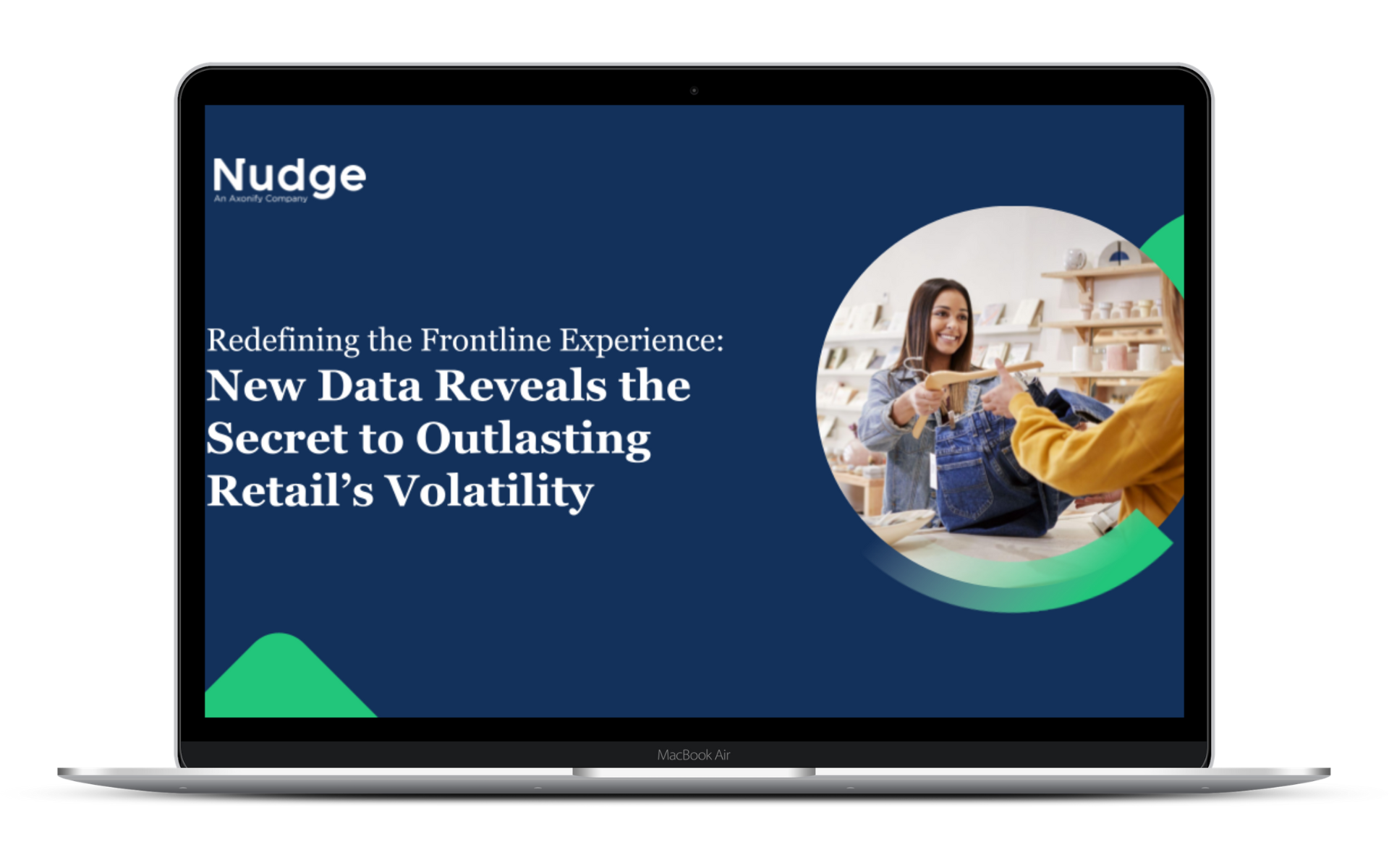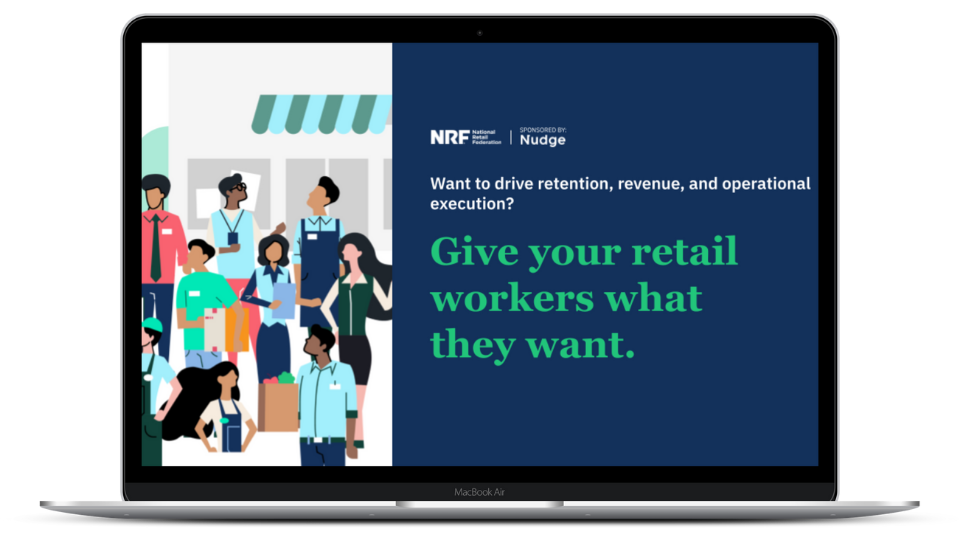
Redefining the Frontline Experience: New Data Reveals the Secret to Outlasting Retail’s Volatility
Redefining the Frontline Experience:
New Data Reveals the Secret to Outlasting Retail’s Volatility

During this webinar, we reveal new findings from Nudge’s annual Deskless Report: Retail Edition, which aggregates insights from managers, workers, and frontline leaders. Get the latest retail-specific data on the critical intermediary role of managers, and what drives associates to perform — and how both can impact the disruptions facing retailers today.
Watch this on-demand webinar to learn how you can apply these findings to:
- Redefine and reimagine the frontline employee experience
- Address key disruptors, like burnout and absenteeism
- Explore the future of frontline enablement technology

The ultimate guide to frontline team huddles
The ultimate guide to frontline team huddles
How to inspire and align your staff (in only 10 minutes a day!)
Looking to streamline processes and drive operational consistency? Reduce the strain on your managers? Drive profitability and expansion? Help communication flow? Keep customer experience top of mind? The answer is simple: pre-shift team huddles.
While team huddles have been the secret weapon of some frontline organizations for decades, these mini meetings are gaining more traction in recent years as alignment and agility are becoming increasingly critical to frontlines looking to grow and thrive.
Morning huddles can help your team stay informed and focused on your organization’s goings-on and core goals – if you do them right.
That’s where we come in. This guide will help you understand why top-performing frontlines use pre-shift team huddles and how to effectively bring these ten-minute miracles to your organization. Plus, we’ll share tried-and-true tips and tricks from our CS team.
So, let’s get started.
What are team huddles?
Also known as pre-shift meetings, morning huddles, lineups, and myriad other names, team huddles are gatherings that provide a chance for frontline teams to quickly connect on the day’s tasks, company updates, team goals or hurdles, and more. Even the deskbound world has begun tapping into these valuable check-ins by utilizing standups and scrums.
Team huddles are more than just a staff meeting. They’re a place for consistent, regular discussion in which employees at all levels communicate, share, and address key performance indicators and areas of improvement. The purpose is to provide an open channel where team members can safely voice any questions or concerns they may have. They should rarely last longer than a few minutes, and are usually led by a location manager.
Huddles are particularly valuable in uncertain times (we see you, global pandemic) or periods of rapid change at an organization, such as during an expansion. But even during “normal” times, every organization can benefit from these bite-sized meetings every day.
Why every frontline needs team huddles
According to our annual research, The Deskless Report, frontline workers are desperate for more on-the-job information. In fact, one of the top reasons that 36% of deskless workers currently want to quit their job is “poor communication.” But information is not always easy to share. Our research also found that according to deskless leaders, the #1 barrier between head office and frontline workers is (you guessed it!) communication.
That’s where team huddles come in. Do they replace your employee communication tools? Nope. But they’re part of your frontline enablement ecosystem, reinforcing timely updates and foundational information, like brand values, while also providing space for real-time feedback and recognition.
Here are a few more reasons every frontline needs team huddles:
They boost team-building
Even when a location only employs a few staff members, teams can become siloed very quickly. The simplest explanation? People aren’t talking to one another. An obvious benefit of a regular touchpoint in the form of a pre-shift huddle can be simple open communication. This leads to a place where employees grow to trust one another and are empowered to work together rather than separately. Pre-shift team huddles are an especially excellent mechanism for team-building between front-of-house and back-of-house staff in the restaurant and hospitality industries.
They create brand advocates
There’s also an employee advocacy play here, too. Employees who feel confident that they have their basic needs met to reach their full potential (things like a safe workplace, fair pay, and the tools to do the job) can become staunch advocates of the brand and company they work for. Ultimately, team huddles lead to engaged, empowered employees ready to collaborate and contribute – and tell the world why they’re proud to be a part of your brand.
They foster a feedback culture
These meetings are the perfect place to foster a sense of safety, share best practices, and allow upward feedback. According to LinkedIn’s Global Talent Trends Report 2020, it’s crucial that employers tap into and act upon employee feedback. By doing this, you are not only engaging your employees but involving them in decision-making. When given the space to share consumer insights, employees can even help increase your organization’s competitive edge.
They promote in-the-moment recognition
All employee recognition is good – but it’s even better when a worker’s hard work is acknowledged in near real time, rather than at the end of the month (or longer!). Team huddles provide the perfect space to share and celebrate. For example, employees at many Enterprise Rent-A-Car locations vote on who delivered the best service during the past week, helping increase connection and add a spirit of friendly competition to their workdays.
They drive consistent task execution
When employees don’t have a good line of sight into what everyone else is working on, there is a danger of duplicating tasks. These redundancies are inefficient and can be significantly negative for your brand if they involve your customers. Pre-shift team huddles allow you to quickly and efficiently create systems that help your business flow better. Taking the time each day, even for as little as ten minutes, to go over priorities and goals can drive consistency and task execution and can increase team cohesion and efficiency. Team huddles also give leaders a chance to act and mobilize their teams to make adjustments that improve customer and employee experience. Quickly sharing bottlenecks and identifying blockers with your team can get more employees focused on a problem so that it can be solved in real time.
They align on company goals
Goals and KPIs are the best way to tell you if you’re on target and let you course-correct to get back on track. And your daily pre-shift huddle is an ideal place for reviewing metric updates, short-term priorities, and overall company goals. Managers can even use huddles to align their teams on priorities and drive performance in a fun way by tying your employees’ successes back to the company’s values and goals.
How to bring team huddles to your organization
Team huddles have the power to drive employee engagement and operational consistency… but to make that happen, you have to be consistent about it. Telling your managers to have a quick ten-minute sync-up each day isn’t enough. You need to implement the right processes and tools to ensure that every location is using huddles the same way. The information shared doesn’t need to be the same across the organization, but the process should be.
Here’s how to implement team huddles at scale:
Step 1: Identify the “why”
If there’s one thing we love here at Nudge, it’s the “why.” When implementing any initiative, sharing the “why” with your staff is the best chance at widespread adoption. But before you can share it with them, you have to identify the “why.” So, why are you implementing team huddles? Which of the business drivers we already explored is most critical to your organization? Are you looking to drive consistent task execution? Are you hoping to open up more channels for upward feedback? Is the business going through a period of growth and you want to keep staff in the know? Thinking about this will help you provide extra context to your staff in a later step.
Step 2: Get the right tech in place
For team huddles to work at scale, you need the right technology and tools in place. Keep in mind: To achieve organizational consistency, you want to standardize the process across locations and regions, while allowing for a certain amount of personalization from managers. Our recommendation? An agenda. More specifically, a frontline enablement solution that combines task management and internal communication. Having your huddle meeting agenda baked right into your existing solution keeps everything in the same place.
Think about it: Let’s say one day’s pre-shift team huddle includes a review of SOP for end-of-day closing. When your agenda is baked into your frontline enablement solution, staff can access the closing checklist – as well as access additional training and learning resources – all in one place. Plus, if a staff member misses the meeting, they can access the talking points and even check off that they have read the information.
Step 3: Get your managers on board
Once you have the “why” and your tech ready to go, you’re prepped to get your manager buy-in. Without your managers, your team huddles will fall flat, fast. It’s critical that you take the time to educate them on the value of these mini meetings – not just for the company as a whole, but for the managers themselves. After all, managers are the ones up against it. Now more than ever, they’re wearing many hats, so finding ways to standardize and simplify processes and protocols is win-win. Share with them the benefits of team huddles and the value of regular, consistent information sharing.
Success tip 💡
If you have a frontline enablement solution in place, you might even be able to back up this information with data, showing how locations that participate in recognition and feedback programs have higher revenue numbers or lower turnover.
Step 4: Share the “why” with your staff
Next, it’s time to loop in your workforce. To encourage widespread adoption of this daily ritual, you’ll want to make sure your workers know the value of these meetings. Here’s where the “why” comes into play again – don’t just explain the new process, explain the reason. So, that message might look like this:
“We’re always looking for ways to improve communication and alignment across the organization and provide additional channels to acknowledge and celebrate your hard work. That’s why we’re excited to announce that we’re implementing pre-shift team huddles at every location. These daily meetings will last no longer than ten minutes and will provide an opportunity for teams to quickly review company announcements and monthly goals, address hurdles or issues, and celebrate staff members who have gone above and beyond.“
Step 5: Standardize the process
The most successful team huddles focus on consistency. To drive operational efficiency, you’ll want to standardize the process, while leaving room for managers to drive their own tactical and engagement initiatives. But how can you ensure that 170 locations across the country (or the world!) are sharing the same information at their huddles?
Here’s where getting the right technology in place pays off. When you execute your huddles through your communication or enablement solution, you’ll be deploying the same agenda items to every location. With Nudge, head office can share mandatory and suggested items with links to relevant resources. Managers can then supplement that agenda with their own custom topics, like star performer call-outs, regional updates, or even add in additional “approved” topics from a head office-populated list.
In the team huddle, managers and employees open up the agenda and review the items for the day, checking them off as they go. This helps huddles to run faster and more effectively, because managers can spend more time on team building and addressing issues versus simply relaying information. The checklist also ensures managers can track who has received the updates, ensuring full, consistent visibility across your workforce (no matter how big!), while still avoiding duplication of information.
Step 6: Monitor at scale
One more reason to deploy your team huddles using a frontline enablement solution: the analytics! Sure, you could leave your managers to conduct these meetings old-school. But leveraging technology ensures that every team huddle can be easily tracked, so you can see at a glance what’s being added to agendas and what topics need more attention – so you can steer the conversation accordingly. You can even see what items are getting checked off and when, allowing you to get full visibility on how information is getting disseminated. Pair this with a resource hub and knowledge-testing questions, and you’ll have the ability to check the confidence and preparedness of your entire workforce. Magical, right?
Success tip 💡
Monitoring at scale can also help to drive company-wide adoption. If you know which locations are consistently doing team huddles (and which are lagging), you can celebrate the behavior you want to drive. Acknowledge the teams that are making team huddles a daily ritual as a way to encourage other locations to follow suit.
The anatomy of a perfect team huddle
You’ve got your tools – check! You’ve prepped your staff – check! You’ve got buy-in from your managers – check! Now it’s time to start running your huddles. But what goes onto the agenda? These meetings are ten-minute miracles for a reason. Anything beyond a few minutes starts to have diminishing returns. So, how do you make those few minutes count?
Download the full guide to learn more!
Download the full guide to read more!
Share your details below to get the full guide, which includes guidelines and examples to help you structure your team huddles, as well as tips to optimize your huddles from our CS team!
Thank you for your interest in our ebook. Access the pdf here.
Visit our Resource Hub to explore additional resources for influencing and inspiring your frontline employees to drive meaningful results.

The ultimate guide to writing and sharing effective frontline communications
The ultimate guide to writing and sharing effective frontline communications
Learn to write clear, creative communications – and save time along the way!

Ah, the struggle of frontline communication teams: you want to do everything you can to drive knowledge retention and employee engagement, but to do that, you need truly effective communications – and that takes a lot of time and effort.
The Nudge customer success team is here to help! In this guide, we’re giving away all our secrets and serving up a collection of tried-and-true tips that any frontline organization can use to write creative, effective communications, while saving time and energy.
Download the guide to learn:
- Why writing creatively is the secret to effective internal communications
- How to write creatively (plus an exercise to put it into practice!)
- How to build a content strategy and use campaigns to save time
- Plus: a free internal communications campaign builder!
Thank you for your interest in our ebook. Access the pdf here.
Visit our Resource Hub to explore additional resources for influencing and inspiring your frontline employees to drive meaningful results.

Give your retail workers what they want
Want to drive retention, revenue, and operational execution?
Give your retail workers what they want.

Long gone are the days when Employee Experience (EX) was just an HR play. Giving your frontline workers what they want – and need – to thrive at work is a clear path to better efficiency, performance, execution, and more.
This is the on-demand webinar every retailer needs to watch. Nudge brings together exclusive market research, real-world examples, and a decade of experience working with top retail brands to answer this critical question: what do retail workers want? Nudge COO Jordan Ekers is joined by Tania Walsh, Manager of Digital Communications Strategy at Telus, and Kathryn Williams, Manager of Retail Communications at Michael Kors to explore what initiatives and programs to implement to drive the discretionary effort every retailer needs.
Watch this webinar to learn:
- Why retailers need to tap into the needs and wants of their workforce
- Why workers crave a sense of purpose at work – and how to bake that into your EX
- The importance of employee community and DE&I programs
- How effective employee communication ties it all together

The frontline leader’s guide to making data-driven decisions
The ultimate guide to frontline team huddles
How to inspire and align your staff (in only 10 minutes a day!)
What does every organization want? Better business outcomes. That means higher profits, lower turnover, and better productivity and efficiency. And the key to shifting the needle on these crucial metrics is simple: your workforce.
To set up your organization to thrive, you need to harness the power of your workforce. In order to do that, you need to be making data-driven decisions based on the needs and demands of your workers.
Wondering where to start? This guide will help you understand what data-driven decisions are and why they’re important. We’ll identify what data to collect, how to harvest the metrics, and learn what to do with data.
Data alone doesn’t tell a story. You need to process and analyze those numbers to find trends and correlations. You need to find the story. As Carly Fiorina, former CEO of Hewlett Packard put it, “The goal is to turn data into information and information into insight.”
So, let’s start turning data into insights.
Why do I need to make data-driven decisions?
How engaged is your workforce? How reachable are your teams in uncertain times? How confident are your employees in executing current or future programs and strategies? These aren’t questions to answer with your gut. These are questions that can – and should – be answered with data.
Making data-driven decisions is deeply rooted in workforce analytics. That’s the process of tracking and analyzing key employee metrics to make fact-based, data-driven decisions to improve performance, engagement, and more. This crucial data can help drive better business outcomes across organizations, everything from sales and CX to operational efficiency and productivity.
Why does workforce analytics matter?
Workforce analytics provide organizations with the data and insights to stay agile and responsive, and set up its employees for success. Here are six reasons workforce analytics matter for your frontline or deskless organizations:
1. It drives performance and productivity
Workforce analytics allow you to answer the questions that can inform crucial decisions around performance and productivity. How consistent are locations in implementing SOPs and protocols? What locations are consistently lagging in performance, and why? How confident are my teams in executing a program or promotion?
Using data from feedback forums, confidence checks, and other sources to answer these questions provides the insights you need to tweak policies, implement new processes, and identify worrisome locations or regions quickly and easily – in short, better support your frontline at scale.
2. It identifies key knowledge gaps
Knowledge gaps cause money loss and safety issues, particularly among frontline and deskless employees, who are at greater risk due to less robust training, poor employee communication, and inconsistent processes (fun fact: ineffective on-the-job training can cost businesses up to $13.5 million per 1,000 employees per year).
But with knowledge testing quizzes and pulse surveys, companies can get far more strategic with their training. Through execution metrics, surveys, knowledge quizzes, and other data, analytics can identify knowledge gaps, protocol confusion, and other red flags. From there, organizations can triage their training to address the most urgent needs, then fill out the rest of the program as more resources become available.
3. It mitigates disengagement and turnover
Do you know whether or not your employees are engaged? How can you be sure?
Only 16% of companies use technology to measure and track employee progress and engagement. Those who don’t rely on a combination of observation, anecdotal evidence, gut feeling, and wishful thinking. This means that you don’t know for sure whether or not your frontline and deskless employees – the ones who are in the most stressful positions – are burnt-out or not. And seeing as burnout is responsible for up to half of workforce turnover, this is definitely an area that organizations can’t ignore.
Data from mental health surveys, feedback forums, and other communication channels can help you establish your workforce’s level of burnout and disengagement. Performance and engagement analytics can further inform the potential business impacts of your situation. With these tools in place, you’ll have an early warning system and be able to act accordingly with disengagement strikes.
4. It highlights the trends that lead to better business outcomes
Workforce analytics have the potential to identify trends that could transform your organization.
Here’s an example: Data analysis might discover that one branch of a retail franchise has consistently better sales, higher employee engagement scores, and lower turnover. You might then discover that this branch’s manager has initiated a few new policies that have completely transformed the location. The organization scales these policies company-wide, and numbers across all branches show significant improvement. You would never have detected that outlier branch without looking at the data.
This may seem like a somewhat extreme example, but it’s not that far-fetched. That’s the power of best practice sharing, and people analytics is the channel to capture these valuable ideas at scale.
5. It identifies star performers
The secret sauce to driving key business initiatives – and ensuring continued growth and success on the frontline – comes down to your top-performing employees. But here’s where it gets tricky. You may have thousands, hundreds of thousands, or (why not?) millions of employees across the country, or even the world. How do you identify your top performers? How do you find the fabled needle in the haystack?
Luckily, there are several proven data points that will allow you to gain a better understanding of both potential and active high performers within your workforce, no matter how large that workforce may be.
6. It improves operational execution
You’ve spent 6 months planning a product launch. You’ve executed on the signage, the PR, the inventory. But… are your associates ready? Here’s another area where workforce analytics can have a major impact on business outcomes. Using a customized concoction of data from surveys, check-ins, and skill-testing quizzes, you can create a crystal ball that will tell you how successful your launch will go before it even begins.

Workforce analytics for frontline and deskless teams: a unique challenge
While reviewing workforce analytics is crucial for any company, it becomes especially valuable for deskless organizations with massive employee bases spread across the country – or the world. Collecting and analyzing workforce data allows you to make informed data-driven decisions so that you can boost the efficiency and operational agility of your teams, no matter the size.
What data to collect
The first step of harvesting data for making data-driven decisions is knowing what metrics to collect. Here’s an in-depth list of the employee metrics that all deskless organizations should track on a regular basis. Depending on the communication and feedback tools you have in place, some of these metrics will be easier to capture than others. We’ll get into collecting your data later, but for now, here’s a metrics wish list:
Communication metrics
These metrics will help you gauge how reachable your workforce is and how effective your communication strategies are.
Adoption and reachability
This is a crucial metric for any communication strategy, answering the question, “Who can I reach?” Ideally, the answer would be 100% of your workforce. Depending on the tools you use to communicate with your workforce, your reachability rate can be difficult to nail down. For example, if you communicate by email, you might be able to calculate how many email addresses you have on file, but you don’t know how many are recent, let alone how often they’re checked. At Nudge, we consider employees reachable if they’ve used our app recently, and we’re confident that your messages will reach them.
Knowledge rates
Generated through knowledge testing and quizzes, knowledge rates can show whether the information that has been shared has been properly retained. This helps ensure that you’re identifying knowledge gaps as quickly as possible.
Open/read rates
Again, this will depend on your communication tools and channels, but ideally you have a metric to track how your workforce is consuming content. What percentage of your staff opened your latest announcement? How many read to the end? How many clicked the CTA at the bottom? How often are SOPs accessed and read? These numbers, where available, will help you see whether your content is actually being read by your employees.
Communication engagement
This metric tracks the level of engagement linked to a specific communication campaign, whether it’s an employee experience initiative, like a wellness month, or a new customer promotion or product feature. Ideally, you can quantify this data even more with a campaign engagement rate, calculated by the number of employees who interacted with the campaign compared to the number of employees who received it.
Feedback metrics
These metrics will help you monitor your feedback channels and capture great ideas, no matter how big your organization.
Feedback participation metrics
To get an at-a-glance understanding of whether you’re fostering a culture of feedback across the organization, look at who is regularly engaging with your feedback channels. Depending on the tools you have in place, you can see who is providing feedback through surveys, forums, or other channels. You may also be able to segment these findings by region or location to identify top-participating groups, as well as those that are quieter.
Feedback sentiment
When you’re collecting feedback from hundreds of thousands of employees, it’s important to have ways to quantify their sentiments at scale. This might be done through sentiment analysis, crowdsourcing/upvoting ideas, and numbers-focused feedback (like multiple-choice surveys). Capturing ideas in these formats lets you turn qualitative feedback into quantitative insights to make more data-driven decisions.
Performance metrics
These metrics will help you successfully execute on key events, like promos and product launches, by understanding how prepared and knowledgeable your employees are.
Execution metrics
Depending on your industry and organization, you might be leveraging standardized task lists within your internal communication strategy to reiterate standard protocols and processes.
Employee performance metrics on frequently assigned tasks and their completion rates will indicate the effectiveness and consistency
of your execution.
Campaign success
Closely tied to execution and confidence are metrics related to a specific campaign or key event, like a product launch or a major organizational change. This could be a combination of metrics around reach, knowledge retention, task execution, sales and revenue, and feedback as an indicator of overall campaign success.
Employee confidence
Employees’ confidence is directly related to their ability to fulfill their job requirements, whether that be speaking confidently to customers about a product or service or executing on a specific task. Capturing data around employee confidence through a survey, knowledge quiz, or forum is a critical metric needed to predict the success rate of key events, like promos or launches.
Engagement metrics
These metrics will help you keep a pulse on employee morale and identify red flags around disengagement and turnover.
Employee engagement metrics
Employee engagement metrics can be measured in a variety of ways. They can be an aggregate metric based on how your employees engage with your communication and feedback channels, or it can be based on dedicated surveys and pulse checks.
Voluntary turnover rate
Voluntary turnover tracks the number of people who have left your organization on their own volition against the average number of employees overall. A high turnover rate means that an above-average number of employees are quitting. One important note: What constitutes a “high turnover rate” will vary according to a number of factors, such as location, industry, and your own historical benchmarks.
Employee advocacy rates
Employee NPS? Yes, it’s a thing. It’s essentially asking whether your employees would recommend your company as a good place to work and/or whether they would recommend your company’s products or services to a friend. Tracking employee advocacy is a good way of tracking overall employee engagement.An engaged employee is more likely to be an advocate of your brand. Conversely, if your advocacy levels are low, there are likely engagement issues within the organization that may be negatively impacting productivity or customer service.
How to collect your data
Now that you know which metrics you want to be capturing, how do you capture them? There are a few different ways to collect workforce data depending on the communication tools you have in place. Here are a few methods to consider:
Download the full guide to learn more!
Download the full guide to read more!
Share your details below to get the full guide, which includes step-by-step instructions on turning data into decisions, the data mistakes every organization makes, and much more. Plus: Printable charts and reference sheets!
Thank you for your interest in our ebook. Access the pdf here.
Visit our Resource Hub to explore additional resources for influencing and inspiring your frontline employees to drive meaningful results.
